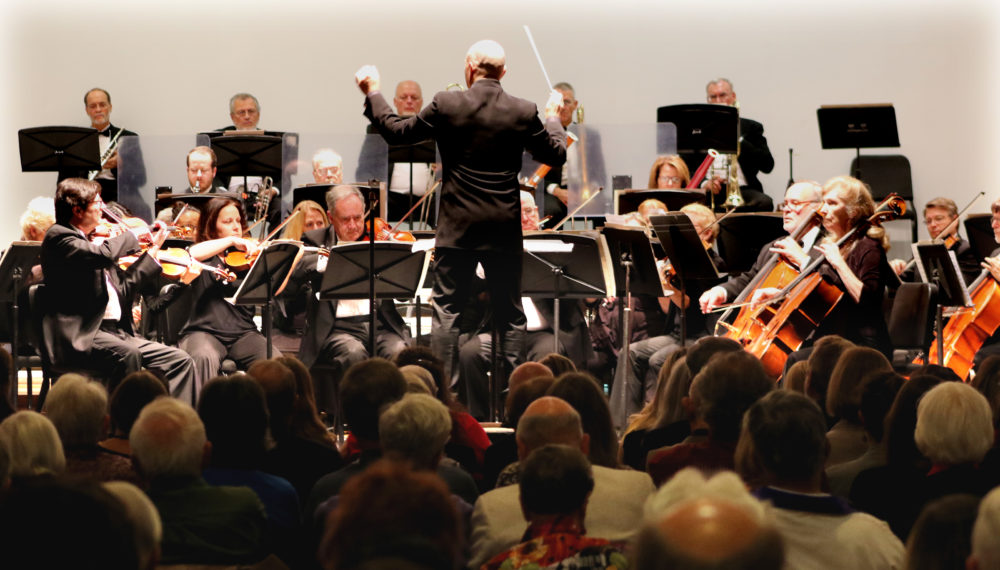COLUMN
THE MUSIC BEAT
CSO Varied Concert
Credit To Conductor

Editor’s Note: This is an assessment of the first of three auditions for the Catskill Symphony Orchestra’s next conductor. Silas Huff directed the CSO Saturday, Sept. 7, at SUNY Oneonta’s Hunt Union Ballroom. Next, on Oct. 12, is Carolyn Watson.
By ROBERT MOYNIHAN • Special to www.AllOTSEGO.com
ONEONTA – At the SUNY Hunt Union Ballroom, an alert and receptive audience Saturday, Sept. 7, heard the first contender for its Catskill Symphony Orchestra leader, Silas Nathaniel Huff. The concert highlighted performances of Haydn, Verdi and Stravinsky. The program began with the younger Strauss’s “Overture to Die Fledermaus.”
The evening was a proving stage for multiple demands of styles from the 18th century to arguably the greatest 20th century modern, Igor Stravinsky. His “Firebird” is as tonally remarkable as anything in the repertoire, including even “The Rite of Spring,” which produced a riot at its first Paris hearing. With repeated performances, “The Rite” has lost some of its revolutionary impudence, and a listener can even hum its first melody.
However, as Robert Craft noted in his first volume of Stravinsky’s letters, “The Firebird’s” success placed the composer on a new artistic planet.
Exciting musical scores often move from lyricism to stages of contrast, and this contradiction marks many of the finest works in orchestral history. Stravinsky seized this technique and drove it to new heights. “The Firebird” moves between sumptuous melody interrupted with aggressive full orchestral declaratives. Its score repeatedly returns to some of the most lyrical and imaginatively scored passages in musical literature.
A minor part of Stravinsky’s reputation rests on his acidic comments about performances and other composers. Some are not to be trusted; they were either initiated or polished in journalistic writing by his final aide. However, clever verbal sallies are not what matter – whoever coined them. They remain incidental amusements. Freshly heard in a lively and well conducted performance, Stravinsky’s music itself remains the final victor.
(If anyone would care to see the pre-Robert Craft Stravinsky in a less exalted role, it exists in George Antheil’s lightly crafted Bad Boy of Music.)
The virtuoso soloist, Andrew Janss, performed the second Haydn cello concerto. Over a period of years, concertgoers hear cellists of varying abilities. Personal favorites were Leonard Rose and Gregor Piatigorsky, both heard in live performances, as well as recordings by many others. One of the problems with this royal instrument can be a highly affected and too pronounced vibrato. The young soloist did not grope for distorted nuances with this much abused device. He, in fact, is one of the finest instrumentalists now before the public, though paradoxically not yet famous. He had total control over an extremely difficult score. It was the greatest pleasure to hear this celebration of artistry. Janss displayed good taste, realized the score’s highest values, and projected musical excitement.
Two works on the program may appear to be bon-bons. They are not. The Strauss is repeatedly surprising in its sophistication and scoring. Oddly, “Die Fledermaus” has not appeared on the local summer opera stage since 1982. It should be programmed instead of the more esoteric though mediocre librettos of recent seasons.
The overture to the revised 1869 “La Forza del Destino” leaps over any of its Verdi predecessors to begin the composer’s final and highly advanced creations. Again, there is the tension of competing orchestration, declarative chordal brass writing with contrasting lyricism horn the strings and winds.
Programming this work immediately before the Stravinsky Firebird revealed that the working of musical tension between melody and aggressive counter-statement is a continuity of the highest musical art – and one should commend the conductor, Maestro Huff, for this realization of both skill and taste – and a display of composers’ creative tensions.
Past conductor Charles Schneider attended the concert – the excellence now so apparent is a tribute to his determined and extended leadership over many years of disciplined interpretations. He built the Catskill – and hearing it is a pleasure. Bravo, Laureate Schneider!
Note: why weren’t there more college students in the audience – narcotized with their ear-plugs and parsing paragraphs horn but one mediocre textbook per course? Would it be too much to expect a college offering on symphonic repertory reflecting Catskill orchestra programs? All it takes is a little imagination, profs. The remarkable Janss spent the night before the concert performing on Main Street and in a downtown Oneonta pub – no doubt the first time college students heard a cello or even a virtuoso performance.
American high schools, generally, have surrendered arts programs, while the tone deaf broadcast Hillbilly inabilities. Unless they are all “hearing impaired,” it would also be encouraging to see several college administrators in the audience. There are many of them.
Robert Moynihan, retired SUNY Oneonta English professor, has retired to the shores of Otsego Lake.

